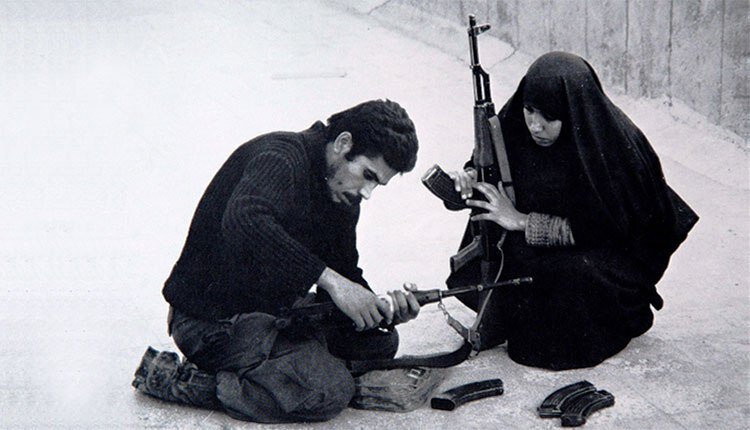Iranian women show indescribable courage in Sacred Defense
Women from the Leader's point of view - Part 5

TEHRAN – Inspired by Islamic teachings, Iranian women with indescribable courage and bravery appeared in various scenes, even on the battlefields during the eight years of Sacred Defense (Iraqi imposed war against Iran in 1980-1988).
Following the victory of the Islamic Revolution of Iran and the fall of the Pahlavi government in 1979 and the subsequent major changes in America's position in the region, the relations between Iran and Iraq also changed.
On September 17, 1980, the former Iraqi president, Saddam Hussein, tore up the 1975 Algerian agreement [An agreement between Iran and Iraq to settle any disputes and conflicts concerning their common border (such as the Shatt al-Arab, known as Arvand Rud in Iran)] by appearing in front of Iraqi television cameras. Five days later at 1:30 p.m. local time, he ordered the Iraqi armed forces to launch a ground invasion of Iran while 192 Iraqi fighter jets bombed twelve key military and commercial airports, including Tehran’s Mehrabad International Airport.
Ayatollah Ruhollah Khomeini, as the leader and Commander-in-Chief of the Armed Forces of the Islamic Republic of Iran, was responsible for its strategic recognition and guidance. Among the actions of Ayatollah Khomeini during the Iran-Iraq war were the mass mobilization and organization of the Iranian people and the armed forces, the development of the military organization, the establishment of coordination and cohesion between the armed forces, and the encouragement of war.
With the start of the war, Iranian women who played a pioneering role in the 1979 Revolution appeared in various scenes, even on the battlefields alongside men with their indescribable courage and bravery.
According to Ayatollah Khomeini, women compared to men had an equal, and even sometimes bigger role in the victory of the Islamic Revolution in Iran.
The eight-year period of Sacred Defense has also left many brilliant memories, performances, and actions of the epic presence of Iranian women. The war as an important factor in social, political, economic, and cultural changes had a great influence on various aspects of Iranian women's lives.
For every male who fought in the Iran-Iraq War, there were at least one and very likely two, three, or four females who helped him fight it. Although history has forgotten this significant fact, it remains nonetheless: millions of Iranian women participated in the war.
During the Iran-Iraq War, women made up a large portion of the domestic workforce in Iran, replacing men who were fighting, injured, or dead.
Taking care of their families and moral support for men who were dispatched to the front; migrating from war zones and becoming familiar with other social environments; and becoming involved in economic issues that had arisen due to the war and international economic sanctions were among the other challenges that Iranian women faced them during the wartime.
Leader of the Islamic Revolution Ayatollah Seyyed Ali Khamenei in one of his speeches pointed to the role of Iranian women in the history of Iran, saying, "Fortunately pious women have been pioneers in different arenas and in different events in our society, not just after the Revolution, but since a long time before the Revolution... The same is true of different other events which took place after the victory of the Islamic Revolution and during the Sacred Defense Era... I have pointed out on many occasions that in my meetings with the families of our martyrs, I have often found mothers more courageous and more resistant than fathers." (May 12, 2012)
Around 25,000 Iranian women also served as doctors and nurses during the Sacred Defence, at least 500 fought as combatants, and at least 170 were taken prisoners of war by Iraq. Iranian women were also active behind the scene of the war in providing key logistical support at the home front. Women voluntarily carried guns, gathered intelligence, operated on the wounded, cared for the injured, buried the dead, guarded ammunition depots, organized kitchens, and cooked food for soldiers.
"The services provided by women behind the front lines, including washing the martyrs' clothes, cooking food, canning fruit, and nursing the wounded are some of the subjects that deserve more analysis and research," Ayatollah Khamenei said. (October 28, 2021)
Irrespective of women’s ideological reasons for participating in the war, it was in Khorramshahr and Abadan [cities in Khuzestan, the southwestern province of Iran] that they most prominently demonstrated their patriotism. Soon enough, other women from throughout Iran joined them in mind, spirit, and body and supported all war efforts from the West to the Southwest.
"Besides, the emergence of the completely outstanding identity and the independent character of Iranian women in the arena of voluntary activities - such as the Sacred Defense Era and its aftermath until today - makes everyone humble. We have had so many wives of martyrs and disabled war veterans, so many mothers of martyrs and so many relatives of those people who laid down their lives in the way of God," the Leader of the Islamic Revolution said. (April 19, 2014)
Considering the fact that the Leader of the Islamic Revolution was one of those who had participated in the early days of the imposed war, he has a special view on Sacred defense and also the presence of women who played a significant role in the war.
Therefore, in upcoming articles, we will address their points of view regarding the presence of Iranian women in the Sacred Defense.
Leave a Comment